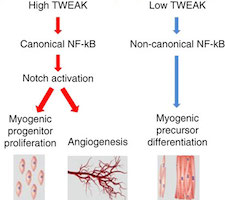
Aloke Finn, MD and colleagues show that mice lacking the protein CD163 show an enhanced repair response to ischemic injury.
CD163 normally restrains TWEAK, which is released by white blood cells in response to injury. TWEAK stimulates muscle and blood vessel growth.
By removing the protein CD163 from mice, scientists at Emory University School of Medicine could boost muscle repair and recovery of blood flow after ischemic injury (damage caused by restriction of blood flow).
The findings point to a target for potential treatments aimed at enhancing muscle regeneration. Muscle breakdown occurs in response to injury or inactivity -- during immobilization in a cast, for example -- and in several diseases such as diabetes and cancer.
The results were published online by Nature Communications on Wednesday, August 5.
CD163 was known to scientists, mostly as a molecule involved in scavenging excess hemoglobin from the body, but its role in regulating muscle repair was not, says senior author Aloke Finn, MD, assistant professor of medicine (division of cardiology) at Emory University School of Medicine.
Mice lacking CD163 showed increased blood flow and muscle repair, compared with controls, after an injury coming from a restriction of blood flow in one leg. Examining the mice lacking CD163, Finn and his colleagues were surprised to find that blood vessels and muscle fibers also grew substantially (roughly 10 percent) in the uninjured legs of the mice.
“We were astonished,” Finn says. “Why would something we did, which caused an injury to one leg, help tissue in the other leg regenerate when it wasn’t injured in the first place?”
Researchers could try to achieve the effect of removing CD163 in humans by giving patients an antibody against CD163, but more research is needed to know how this might work. CD163 levels have been found to increase in aging humans.
Finn and his colleagues found that macrophages, which are a type of white blood cell, appear to release a soluble form of CD163 in response to injury. In the blood, CD163 soaks up and counteracts another protein called TWEAK, which stimulates muscle cells to multiply.
In CD163’s absence, TWEAK can have a greater effect, and can apparently stimulate muscle growth distant from the site of injury. When infused into normal mice, TWEAK does not have any effect on muscle growth, possibly because of circulating CD163.
Scientists that study muscle cells have been interested in TWEAK for several years, but some studies have suggested that TWEAK negatively regulates muscle regeneration – the opposite of what Finn’s team observed. To prove that TWEAK was needed for the extra repair seen in mice lacking CD163, the Emory researchers showed that if they injected an antibody against TWEAK, thus removing it from the blood, it eliminated the extra repair activity.
“I think our results show a specific mechanism by which muscle regeneration takes place. TWEAK can be a pro-regenerative factor,” Finn says, “but its effects have to be transient and limited.”
TWEAK is thought of as transmitting inflammatory signals because it activates a master regulator of inflammation called NF-kB. While chronic inflammation is bad for muscle growth, in the mice lacking CD163, the signals coming from increased TWEAK are helpful for regeneration.
“Ischemic injury is a situation in which TWEAK can stimulate muscle progenitor cells to proliferate,” Finn says. “But if you have lots of TWEAK around all the time, the muscle cells don’t know when it’s time to differentiate and mature. “
Finn says his team is currently investigating CD163’s effects on atherosclerosis. The first author of the Nature Communications paper is postdoctoral fellow Hirokuni Akahori, MD, PhD.
The research was supported by the American Heart Association, the Carlyle Fraser Heart Center and by Emory's Woodruff Health Sciences Center.
